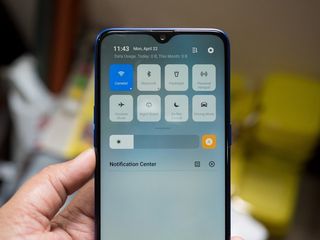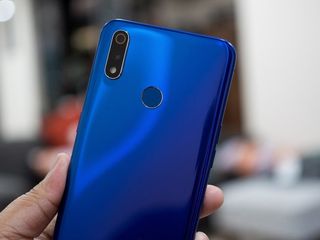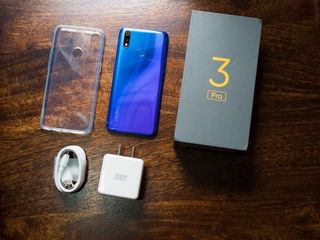I haven't talked about Realme a lot, but the brand has done exceedingly well in India over the last 12 months. In that time it launched seven phones, racked up sales in excess of 2 million, and grabbed a vital foothold in India's budget segment.
The brand's origin story is interesting as it was designed for one reason and one reason alone: to thwart Xiaomi in the budget category. Even the Realme name itself is a play on the Redmi moniker that Xiaomi uses on its budget phones. Realme also offers great value for money, and thus far the brand's strategy seems to be to roll out similar hardware as Redmi devices at a slightly lower price point. And if its sales figures are any indication, the move is paying off.
Realme is able to undercut Xiaomi because of backing from OPPO — it started out as OPPO's sub-brand in the budget segment. However, that has changed in the last six months as Realme has become a standalone entity, but the manufacturing itself and the sourcing of components is all done by OPPO. Think of Realme, then, as the OnePlus of the budget category.
The Good
- Class-leading internals
- Gorgeous design
- Excellent value
- 20W fast charging
- Two-day battery life
The Bad
- Micro-USB
- Single speaker
Realme 3 Pro Hardware

At a first glance, it's immediately evident that Realme is mimicking a similar design aesthetic as the Redmi Note 7 Pro. The back of the Realme 3 Pro has a gradient pattern, and more than once I picked up the Redmi Note 7 Pro thinking it was the Realme 3 Pro. There's also a "Light Grating effect" underneath the gradient design with curved lines in an S pattern, with Realme saying that the design is an homage to the Esses at the Le Mans racetrack.
Unlike Xiaomi, Realme isn't using glass at the back of the 3 Pro. The device instead features injection molded plastic, and the build quality as well as fit and finish are top-notch. The gradient at the back shifts between several hues of blue — you'll also be able to pick it up in Lightning Purple and Carbon Gray options — and overall the device looks fantastic.
There's a subtle curve where the back meets the mid-frame, and that makes it easier to hold the device comfortably. Up front you get a tiny dewdrop cutout that houses the front imaging module and the earpiece, with the screen boasting a 90.3% screen-to-body ratio.
The phone has a 16MP + 5MP camera configuration at the back, and the sensors are arrayed vertically on the top left corner. There is a slight bump that makes the phone wobble when using it on a flat surface, but it doesn't affect usability in any significant way. There are chrome accents around the camera housing at the back and the fingerprint sensor, and the Realme logo is prominently highlighted at the bottom.





The front of the device is dominated by a 6.3-inch FHD+ IPS LCD display. Colors and vibrant out of the box, and the screen fares well under harsh sunlight. There's an option to adjust the color temperature to your liking, switch up the display scaling, and set up a blue light filter. The tiny cutout at the top makes the display that much more immersive, and it is one of the better panels I've come across in the budget segment.
The screen is protected by Gorilla Glass 5, and it comes with a factory-installed screen protector. It's the usual plasticky affair, and you're better off picking up a more robust solution if you decide to use one after all. There's also a clear case bundled in the box.
Now onto the interesting bit: the internal hardware. As I mentioned earlier, Realme's goal is to best Xiaomi in this category. So with the Redmi Note 7 Pro running a Snapdragon 675, the Realme 3 Pro had to feature a more powerful chipset, and it does so in the form of a Snapdragon 710.
This is the first time a Snapdragon 710 is being offered at this price point.
Qualcomm's naming convention could use some work, but essentially the 7xx series is meant to be targeted at the mid-range while the 6xx platforms are aimed at the budget segment. The Snapdragon 710 in fact made its debut on the Nokia 8.1, a fantastic mid-ranger that retails for double the cost of the Realme 3 Pro.
But the distinction between the 7xx and 6xx tiers has blurred with recent launches, and that's evident when you look at the Snapdragon 675's specs. The chipset is fabricated on a 11nm node — versus 10nm on the 710 — but it has newer Kryo 460 cores, whereas the 710 has third-gen Kryo 360 cores. Both offer a similar level of performance in the real world, but it just goes to show just how confusing Qualcomm's mid-range portfolio is getting.
That said, there is one distinct advantage with the Snapdragon 710: the Adreno 616 GPU. The Adreno 616 has more video memory than the Adreno 612 on the Snapdragon 675 and is clocked higher. But more importantly, it is compatible with Fortnite, and (for now at least) the Adreno 612 is not.

That means the Realme 3 Pro is the first phone in the budget segment that lets you play Fortnite, and that's a pretty big deal. PUBG dominates the conversation around mobile gaming in India, but the fact that you can play such an intensive game as Fortnite on a budget phone is a win for Realme.
The game itself loads at medium quality, and while the quality of the visuals wasn't great, it ran smoothly and delivered a near-constant 30 frames a second. The phone fared better at PUBG, and in general is the device to get if you're in the market for a gaming phone on a budget. There's also a dedicated Game Space feature that limits notifications when you're in a game, and it offers tools to easily record your game footage and share it online.
Xiaomi, for its part, has stated that the Snapdragon 675 is 16% faster than the Snapdragon 710, but that's mostly on the CPU side, and you don't notice it in day-to-day use. What you do notice is the fact that the Realme 3 Pro lets you play Fortnite, and Redmi Note 7 Pro does not. Following Realme's announcement that its device will be able to run Fortnite, Xiaomi has said that it is working with Epic Games to bring the game to the Redmi Note 7 Pro as well. But as is often the case with these things, there's no timeline for when that will occur.
The Realme 3 Pro is the budget phone to get if you're interested in gaming.
As for real-world usage, I had zero issues with the Realme 3 Pro. The hardware on offer makes it one of the fastest phones in this segment, and there were no lags or slowdowns in the two weeks I used the device. Wi-Fi connectivity was great as well, and calls over VoLTE went through without any hassle.
The Realme 3 Pro also scores highly elsewhere. The software-based face unlock is incredibly fast, and if you need a more secure solution there's a capacitive fingerprint sensor at the back. The device comes in three variants: a base model with 4GB/64GB, followed by 6GB/64GB and 6GB/128GB memory and storage configurations.
There's FM radio, Wi-Fi ac, Bluetooth 5.0, a 3.5mm jack, a dedicated MicroSD card slot along with two SIM slots, and a 25MP camera up front. The one area where the Realme 3 Pro falls short on the hardware front is the Micro-USB port. Realme says the data it received from customers didn't suggest an immediate need to switch to USB-C, so it'll be a while before we see the newer charging port make its way to the brand's devices.
That said, the phone offers OPPO's VOOC 3.0 20W fast charging, and the bundled charger lets you charge at 20W speeds. This area is usually a pain point for Xiaomi customers as the brand is known to bundle 10W chargers even for devices that support fast charging, so the fact that you get a 20W VOOC 3.0 charger in the box with the Realme 3 Pro is a big deal.
On the subject of charging, the phone comes with a 4045mAh battery, marginally larger than the 4000mAh unit on the Redmi Note 7 Pro. Battery life is similarly outstanding, and I never saw the battery going below 15% after a single day's worth of use. And when you do need to top up, VOOC 3.0 charges the device from flat to 50% in just 30 minutes, with a full charge taking just over 80 minutes. And if you're playing a game while charging, you'll still get a 60% charge after an hour.
Realme 3 Pro Software

Realme relies on OPPO not only for hardware, but also for the software. The Realme 3 Pro features ColorOS 6.0 based on Android 9.0 Pie out of the box, and there are some significant changes on offer. The key is a new design language that looks cleaner and much more modern than previous versions of ColorOS. The color palette sees white mixed in with blue and green accents, and overall the interface looks much better.
ColorOS 6.0 looks modern, has an app drawer, and doesn't contain ads.
Another key change is the addition of an app drawer, which is enabled by default on the Realme 3 Pro. The notification shade has big rectangular toggles, and there's a nifty Clear all button to dismiss all notifications at once. There's a decent amount of customizability on offer, and you get navigation gestures as well as screen-off actions, dual apps, a built-in driving mode and a riding mode for two-wheelers, and so much more.
Overall, the changes in ColorOS 6.0 make a drastic difference in day-to-day usage. The skin no longer feels like an iOS clone, and the color scheme gives it a modern look that complements the hardware very well.
My review unit was running pre-release software out of the box, so a few features were missing. Widevine L1 wasn't available, as was 960fps slow-mo video recording. Realme says there wasn't adequate time to add the features to review devices, but mentioned that both will be available on retail units.
Realme 3 Pro Camera

The Realme 3 Pro is using the same IMX 519 camera sensor as the OnePlus 6T, and that makes things very interesting. The OnePlus 6T isn't particularly known for its camera prowess, but the fact that the Realme 3 Pro — which costs less than half as the 6T — has the same sensor is a big deal.
The camera interface is fairly intuitive: you swipe left or right to switch between photo, video, and portrait modes, and there are toggles for HDR, flash, photo filters, and settings. One of the toggles is for Chroma Boost, which relies on AI to boost colors and dynamic range in shots. Resultant images tend to be oversaturated, but they look great for sharing on social platforms.
There's a dedicated night mode that selectively boosts exposure in low-light conditions, leading to better shots. It's not anywhere as good as Night Sight, but it delivers passable shots in scenarios with little to no light. Google Lens is integrated into the camera interface, and you get a decent number of shooting modes: panorama, manual, and slow-motion. The phone has a 960fps super slow-mo feature that shoots at 720p, but as I stated above it wasn't available on my review unit.






Overall, the Realme 3 Pro manages to do a great job in this area. Photos taken in daylight come out gorgeous and full of detail, and the phone also fares pretty well in low-light shooting scenarios.
Realme 3 Pro Bottom line

If Realme has shown anything in the course of the last year, it's that consumers in this segment don't have any affinity toward a particular brand — at least in the budget segment. It was able to steal a lot of users away from Xiaomi by offering a more feature-rich device, and the Realme 3 Pro kicks things up a notch in that regard.
4.5 out of 5
There's no shortage of devices that offer great specs in this category, but the Realme 3 Pro scores a few key victories. The internal hardware is some of the best you'll find in this category — the ability to play Fortnite is a major win — and the software isn't bogged down by ads. The design is evocative, the camera is brilliant, the device easily delivers two-day battery life, and you get a 20W fast charger in the box. If there's anything missing here, I'm not seeing it.

Harish Jonnalagadda is a Senior Editor overseeing Asia at Android Central. He leads the site's coverage of Chinese phone brands, contributing to reviews, features, and buying guides. He also writes about storage servers, audio products, and the semiconductor industry. Contact him on Twitter at @chunkynerd.
